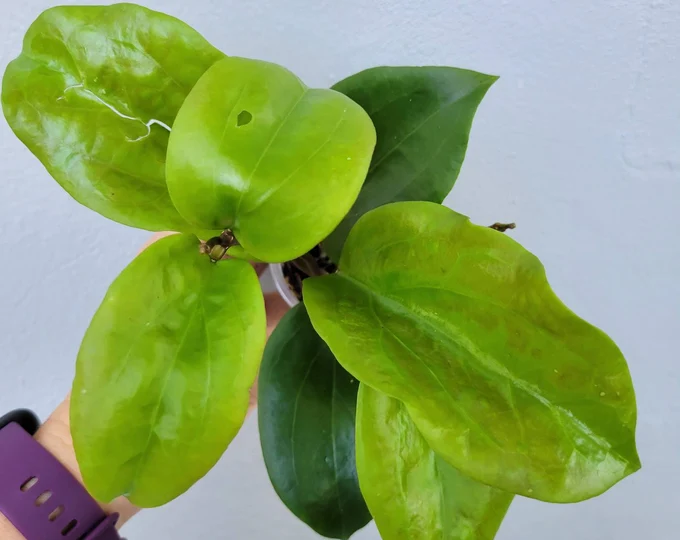Hoya plants, sometimes known as wax or porcelain flowers, are well-known for their lovely blossoms and decorative leaves.
Although there are many websites about Hoya plants, I’ve noticed there isn’t much information available on how to care for the Hoya Surigaoensis. The purpose of this post is to provide reliable and helpful information on Hoya Surigaoensis plant care. Read on to discover how to make your hoya survive and thrive!
In This Article
How to Care for the Hoya Surigaoensis?
Grow your low-maintenance hoya in bright or medium light. When the potting soil becomes dry, water the hoya. Don’t overwater it, please.
Although low-maintenance hoya plants don’t require a lot of fertiliser, fertilize if you want your hoya to bloom more profusely. Use any all-purpose indoor plant fertiliser as directed on the container.
Hoya plants are among the easiest when it comes to indoor plant maintenance. That said, I have cared for many Hoyas at the nursery over the years and have discovered that each has unique preferences.
Today, I will be giving you insider tips on how to care for the Hoya Surigaoensis. You’ll learn the ins and outs of Hoya Surigaoensis plant care, get tips for encouraging blossoms, and answers to any questions you might have.
Sunlight Requirements for Your Hoya
When you’re growing hoya surigaoensis, flowering is a sure sign of a healthy and happy plant.
There are several elements that affect flowering, but sunshine is the most essential one. Although hoyas do grow pretty well when exposed to less light, they require intense indirect light to flower. Be careful because excessive sun exposure could cause their leaves to scorch or become yellow.
Put them in a location with plenty of indirect light.
If you’re growing your hoya indoors, artificial light is also ideal.
Watering Your Hoya
Hoya plants prefer their soil to be absolutely dry between waterings, just like other succulents do. Some individuals even wait to give their leaves a drink until they begin to wrinkle or pucker slightly.
Make sure to thoroughly soak them in water when you do. Ensure it all drains, and don’t forget to empty the saucer of extra water.
The bottom leaves of the vine will begin to yellow if the plant becomes overly dry, which is uncommon. On the other extreme, the plant will try to expel moisture by shedding leaves if it is excessively wet.
Keep in mind, these plants will require even less watering when they are dormant in the winter.
Humidity
Hoyas are tropical plants that do well in moist environments. Increase the humidity by using a humidifier, especially during the winter when indoor air tends to be dry.
As the water evaporates in a saucer filled with pebbles and water, humidity is also produced.
Avoid spraying the flowers; rather, mist them with water that is at room temperature.
The Perfect Soil and Repotting
Besides sunlight, water, and organic matter, another element that’s crucial to your plants is adequate air circulation. Although you might assume that plants placed outside would have plenty of air, that isn’t always the case. Plants kept indoors may do even worse. Most hoya plants are epiphytes, meaning they prefer to grow on another plant or object for physical support.
They also grow best in a medium that maximizes the root’s exposure to the surrounding air where they can derive more nutrients.
Hoyas prefer to be confined to or crammed within their pots. Only every two to three years will they need to be replanted. Being root-bound doesn’t bother hoyas. Maintain the same container for many years, but don’t forget to fertilise in the spring and summer.
Be gentle with the plant if you decide to repot it: Repot in the spring, wait 2-3 days after your last watering, and treat the roots with extreme care. Simply knock off any loose soil instead of completely removing the old soil.
Pruning
Prune in the spring before active growth starts. Spurs are stems that don’t have leaves, and they shouldn’t be cut off.
Year after year, the same spurs produce flowers. Hoyas are vining plants that will gladly droop from a window sill or shelf.
On the other hand, they are frequently trained into circular or vertical trellises, giving the impression of a stronger plant.
Fertilising Your Hoya
Even seasoned growers of houseplants find it difficult to know when to feed their Hoya Surigaoensis. The Hoya Surigaoensis is just like any other Hoya plant, so it needs enough nourishment for it to grow well. That’s why I like to use two different types of fertiliser.
Keep in mind that every gardener will have their own methods. As a result, our feeding schedules will differ greatly. For example, I prefer to apply a fertiliser with more phosphorus to aid in the plant’s eventual bloom.
I have found that during its growing season (spring and summer), a balanced houseplant fertiliser diluted to half strength once a month works exceptionally well.
Hoya Surigaoensis Problems & Troubleshooting
Mealybugs, spider mites and aphids are the most common pests that will bother the Hoya Surigaoensis. While all of these are tiny, they can cause significant damage if you don’t spot them early or treat them quickly. That’s because they can quickly grow into an infestation.
Numerous pests can be eliminated by water-spraying your hoya plant. Make sure to spray the entire plant. Spider mites can be managed with frequent water sprays. A pest invasion can also be stopped in its early stages by spraying the plant with insecticidal soap.
Diseases
The biggest danger to watch out for is overwatering, which can cause root rot. As if that weren’t bad enough, the wet circumstances encourage the growth of germs and fungi, which can lead to sickness.
Always leave the soil and leaves to dry. Take caution when watering and keep the plant in bright, indirect light with excellent airflow to hasten drying.
Where to Buy a Hoya Surigaoensis
Final Verdict
Overwatering, which can result in root rot, is the main risk to be aware of when taking care of hoya plants. Besides root rot, the damp conditions promote the growth of bacteria and fungi, causing disease.
Therefore, make sure the leaves and soil have enough time to dry in between waterings. It helps to keep the plant in bright, indirect light with good airflow to accelerate drying.
Frequently Asked Questions
Additional Sources & Resources
-Hoya surigaoensis species information from the Philippine Native Plants Conservation Society, Inc. (PNPCSI)
http://www.pnpcsi.org/species/hoya-surigaoensis/
-Hoya surigaoensis species information from the Encyclopedia of Life
http://eol.org/pages/485506/overview
-A review of the genus Hoya (Apocynaceae) in Mindanao, Philippines by Aruna Weerakoon and Phillip Cribb
http://www.repository.naturalis.nl/document/565297
-Hoya surigaoensis information from the Plant List
http://www.theplantlist.org/tpl1.1/record/kew-2678095
-Hoya surigaoensis information from Plants of the World Online
http://www.plantsoftheworldonline.org/taxon/urn:lsid:ipni.org:names:77153734-1
Image credit: etsy.com

